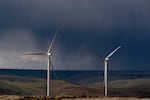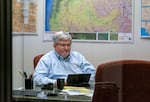Northwest leaders set renewable energy goals, but neglected a key element required to achi
May 17, 2025

Oregon and Washington have some of the most ambitious clean energy goals in the country. They’ve vowed to replace all of the states’ electricity with renewable sources. The states’ politicians have campaigned as climate champions — despite President Donald Trump’s opposition to renewable energy.
But an investigation by OPB and ProPublica found that these states aren’t actually leading. As climate reporter Monica Samayoa and investigative editor Tony Schick reported, nearly every other state is adding renewable energy at a faster rate.
Samayoa joined OPB “All Things Considered” host Geoff Norcross to share the results of their investigation.
Listen to the conversation by tapping play on the audio player below. The following transcript has been lightly edited for clarity.
00:00
/
05:23
Geoff Norcross: Hello, Monica. What did you find?
Monica Samayoa: I’ve been covering the renewable energy transition for a few years now. One of the biggest things that I’ve learned that we need in order to get to 100% renewables by midcentury is, well, adding more wind and solar to our power grid.
But our wind and solar use in Oregon has remained low and is still far behind fossil fuels like natural gas and coal. Tony Schick and I wondered why. What we found: Over the past decade, Oregon ranked 47th in the nation for bringing new renewables onto the grid and Washington ranked 50th.
That’s really bad coming from states that pride themselves on their ambitious climate laws and how green we are.
I talked to Democratic Oregon Rep. Ken Helm about it and here’s what he had to say.
Ken Helm: Senators and representatives like me, we cannot continue to believe our own PR, that we have been successful in promoting a renewable electricity future. We are not heading in that direction, and we’re going to have to take action to change that or nothing will happen.
Samayoa: In comparison, many Republican states with no mandates, like Texas and Iowa, are ahead of us now.
Norcross: Why? What’s holding things back in the Northwest?
Samayoa: There’s a few things that cause a domino effect. The biggest problem is there are not enough transmission lines. So those are the very big power lines that you see along Interstate 5. Those carry electricity from one place to another.
Related: How the Pacific Northwest’s dream of green energy fell apart
Another domino is that the Bonneville Power Administration owns 75% of all these lines in the region. They used to build hundreds of miles decades ago. But in the past five years, we found that they’ve only built one mile of transmission.
They currently have an enormous backlog of renewable energy projects they need to study before giving the OK to build. And that makes it super difficult and expensive for renewable energy developers to take these projects on. We spoke with a Portland-based developer that has been waiting years to get the greenlight for a project, which could help power about 100,000 homes.

Bonneville told us they have taken some steps to improve the process. They have vowed to invest $5 billion to upgrade transmission lines — but it’s iffy now, since the Trump administration’s massive federal job cuts hurt the agency.
Norcross: Yeah, OK. It’s a lack of transmission that’s stifling our push for clean energy. Now is that something lawmakers were thinking about when they passed the mandates?
Samayoa: What I heard from Oregon lawmakers that pushed to require electricity utilities to be carbon-free by 2040, it was not at top of mind — at least for some.
Republicans at the time did raise concerns, claiming that the state’s transmission lines were maxed out. But they weren’t taken seriously.
When I spoke with Oregon Democratic Rep. Pam Marsh, one of the leaders of renewable legislation, she told me they were more focused on utilities rather than transmission at the time.
Pam Marsh: I was not thinking personally about what role Bonneville might play in this.
Samayoa: And a bit of a similar situation in Washington state, lawmakers didn’t do anything to address the transmission bottleneck.
This year, there was a push to create independent authorities to finance transmission lines, as that is another barrier to getting more built out, but it failed in both Oregon and Washington legislatures.
Norcross: OK. So we vowed to only use clean energy, but we’re way behind in adding new sources of it. Meanwhile, the latest forecast shows Northwest energy demand is skyrocketing because of, among other things, new data centers. What are the consequences of failing to add renewable energy?
Samayoa: It depends on who you talk to.
We may reach a point that we are not going to have enough energy sources either from wind, solar, fossil fuels, you name it to power our homes — and it would make life very difficult.
Related: The Northwest is bracing for the effects of a lagging green energy push
The reality is Oregon and Washington are not going to meet their renewable goals. And it’s going to lead to a lot of issues.
We’ve heard from Bonneville that it’s going to be OK and the potential for blackouts in the Pacific Northwest is incredibly low.
But not everyone agrees.
Here’s Nicole Hughes, she is the executive director of the group Renewable Northwest.
Nicole Hughes: I do think we’re in a situation where, in the next few years, we may start having to make some tough choices about the availability of electricity.
Samayoa: And the energy experts say if leaders in the region don’t solve this problem, we could face a growing threat of blackouts in the Pacific Northwest.
Search
RECENT PRESS RELEASES
Related Post




